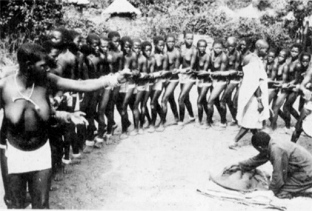
TSHENGEDZO - Punishments
Abstract This section reproduces "Songs, Dances, Mimes and Symbolism of Venda Girls' Initiation Schools (Part 3): Domba." It begins with a general introduction to the domba school, the final phase in the girls' initiation cycle, which generally lasts for about a year. In this section Blacking argues that the primary role of domba is to teach young girls how they can assist in the tribal economy, both as producers of labour and reproducers of the labour force within the institutionalised context of marriage. 'Categories of Action in Domba' outlines three activities girls engage in during domba which are specific to this phase of initiation: dzingoma (essential rites), The paper concludes with 'Notes on the Musical Transcriptions', which provides information on some of the musical features of the domba repertoire; further analysis of these songs is taken up in Part 4, 'The Great Domba Song' under the heading 'Tshilalelo, and Other Songs of Domba'. Unlike the songs of vhusha, the domba songs were transcribed at the pitches normally used by the girls in performance. Readers with a music background may find it useful to read through the notes on the musical transcriptions before looking at the 'Categories of Action in Domba', where the transcriptions are located. |